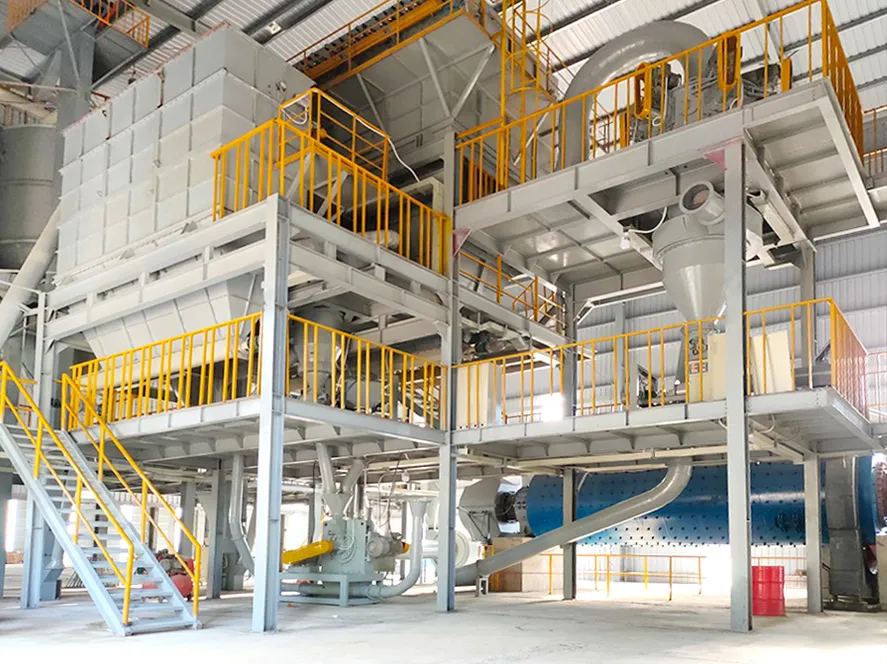Heavy calcium powder, also known as heavy calcium carbonate (CaCO3), is widely used in various industries due to its unique properties. The production of high-quality heavy calcium powder requires the use of specialized equipment capable of achieving the desired particle size distribution. In this article, we will explore the process of producing heavy calcium powder and discuss the primary production equipment ideal for producing 10μm heavy calcium powder.
Understanding Heavy Calcium Powder:
Heavy calcium powder refers to finely ground particles of heavy calcium carbonate. It is derived from natural limestone or marble deposits through a series of extraction, crushing, grinding, and classification processes. Heavy calcium powder is characterized by its higher density, larger particle size range, excellent whiteness, and chemical stability.
Production Equipment for Heavy Calcium Powder:
To produce 10μm heavy calcium powder, several key pieces of equipment are essential. These include:
- Crushers:
Crushers are used to reduce the size of raw materials such as limestone or marble before further processing. Jaw crushers or impact crushers can be employed to achieve the desired feed size for subsequent grinding operations. - Grinding Mills:
Grinding mills play a crucial role in reducing the particle size of heavy calcium carbonate to the desired fineness. Several types of grinding mills are commonly used:
- Raymond Mill: Raymond mill is a traditional pendulum mill that operates by applying grinding rollers onto a grinding ring. It offers high efficiency and precision in achieving the desired particle size distribution.
- Ball Mill: A ball mill uses steel balls or other media to break down the coarse particles of heavy calcium carbonate. It is effective in achieving fine and ultra-fine grinding results.
- Vertical Roller Mill: A vertical roller mill utilizes rotating rollers to crush and grind the heavy calcium carbonate against a grinding table. It provides excellent control over particle size and allows for precise adjustments.
- Classifiers:
Classifiers are crucial for separating and classifying the ground heavy calcium particles according to their size. Precise control over the particle size distribution is achieved using classifiers. For producing 10μm heavy calcium powder, the following classifiers are commonly used:
- Air Classifier: An air classifier utilizes air flow and centrifugal forces to separate particles based on their size and density. It allows for accurate classification and ensures that the desired level of fineness is achieved.
- Turbo Classifier: A turbo classifier employs a combination of centrifugal force and drag force to classify particles. It provides efficient classification and can be suitable for producing 10μm heavy calcium powder.
- Air Separators:
Air separators are used to remove fine particles from the heavy calcium powder. They ensure that the final product meets the required standards of purity and quality. Efficient air separators contribute to achieving the desired particle size distribution and preventing oversize particles from contaminating the final product.

Considerations for Producing 10μm Heavy Calcium Powder:
To produce 10μm heavy calcium powder, several factors should be taken into consideration:
- Equipment Selection:
Choosing the right equipment is crucial for achieving the desired particle size distribution. Grinding mills with advanced capabilities and precise control mechanisms are preferred for fine grinding operations. - Operating Parameters:
Optimizing the operating parameters of the production equipment is essential. This includes adjusting the grinding speed, feed rate, and classifier settings to achieve the target particle size range. - Quality Control:
Implementing a robust quality control system helps ensure consistent and high-quality heavy calcium powder production. Regular monitoring of particle size, whiteness, chemical composition, and other relevant parameters is necessary to meet customer requirements.
Producing 10μm heavy calcium powder requires the use of specialized equipment capable of achieving the desired particle size distribution. Crushers, grinding mills (such as Raymond mills, ball mills, and vertical roller mills), classifiers (including air classifiers and turbo classifiers), and air separators are essential for the production process. Selecting the right equipment, optimizing operating parameters, and implementing rigorous quality control measures contribute to achieving high-quality heavy calcium powder suitable for various industries. By understanding the production equipment and processes involved, manufacturers can successfully produce 10μm heavy calcium powder to meet the specific needs of their customers.
